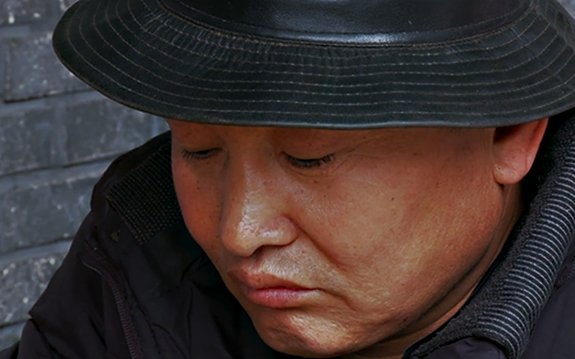
The residents of Beijing’s Songzhuang Artists’ Colony like to roam and love to drink, and when they combine the two, they need a ride home. That’s where Lao Jin comes in. Lao Jin is designated driver to the luminaries of Beijing’s rising art world and the focus of a new documentary by Xu Xing and Andrea Cavazzuti, titled 5+5. But he is more than just a taxi driver. With his baby face framed by prayer beads and a fedora, Lao Jin looks on as a sort of wry everyman while his patrons sculpt, paint, do performance art, and occasionally get hauled away by the police.
Although he relies on their patronage to make a living, Lao Jin doesn’t keep his distance from those he chauffeurs—he banters and badgers, shares financial worries, offers uncanny pop-criticism of their work, asks for prints, and promotes their cause to anyone who will listen. “Understand?” he asks a baffled onlooker at a “happening,” as one artist busies himself stacking bricks and another strips naked and scrapes his ass across a road sign. “If you don’t, watch and learn.”
Part 1
Part 2
The film was originally screened at Barnard College in October as part of Guernica’s media partnership with Barnard’s International Artists Series (BIAS), and is presented here in its entirety, thanks to the filmmakers. Its runtime is 86 minutes. For more Guernica Movies, check out Plastic, Repurposed and Crossing the American Crises.
Xu Xing is a Beijing-born filmmaker and avant-garde writer. His collection of short stories, Variations Without a Theme, and novel, All That Is Left Is Yours, have been translated in many languages, and he’s been named the “Chinese Jack Kerouac” by foreign critics. His film work focuses on subjects such as the Cultural Revolution (“A Chronicle of My Cultural Revolution,” France TV5) and the poor, weak, and mistreated in Chinese history and contemporary society.
Andrea Cavazzuti is an Italian sinologist and filmmaker who has lived in Beijing since the early 1980s. He began as a still photographer in the late 1970s and turned to digital video in the 1990s. He also works as a director, producer, and editor of feature films, documentaries, and video art.
